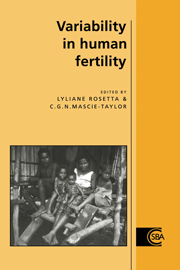Book contents
- Frontmatter
- Contents
- List of contributors
- 1 Introduction: the biological anthropological approach
- PART I HORMONAL ASPECTS OF FERTILITY REGULATION
- PART II INTERPOPULATION VARIABILITY
- PART III METABOLIC AND ENERGETIC ASPECTS OF REGULATION
- 8 Metabolic adaptation in humans: does it occur?
- 9 Possible adaptive mechanisms for energy saving during physical activity
- 10 Body composition and fertility: methodological considerations
- 11 Breast-feeding practices and other metabolic loads affecting human reproduction
- Index
11 - Breast-feeding practices and other metabolic loads affecting human reproduction
Published online by Cambridge University Press: 03 February 2010
- Frontmatter
- Contents
- List of contributors
- 1 Introduction: the biological anthropological approach
- PART I HORMONAL ASPECTS OF FERTILITY REGULATION
- PART II INTERPOPULATION VARIABILITY
- PART III METABOLIC AND ENERGETIC ASPECTS OF REGULATION
- 8 Metabolic adaptation in humans: does it occur?
- 9 Possible adaptive mechanisms for energy saving during physical activity
- 10 Body composition and fertility: methodological considerations
- 11 Breast-feeding practices and other metabolic loads affecting human reproduction
- Index
Summary
Introduction
Few would dispute that, throughout the animal kingdom, successful species need to be able to increase their numbers when environmental conditions are favourable. The converse of this, that reproduction should be restricted in situations when a successful outcome is unlikely is also a clear evolutionary advantage, particularly for altricial species such as man with his long reproductive cycle and low rate of reproduction. Food supply is arguably the most potent evolutionary pressure, so some relationship between nutrition and reproduction must surely be expected. However, just how closely these factors are integrated, the mechanisms of the association and the overall impact of the relationship on lifetime fertility remain subjects of considerable controversy.
It is now several years since the concept of the baby in the driving seat was proposed in an attempt to explain some of the substantial variability observed in the duration of or lactational amenorrhoea (Lunn, 1985). In particular, the theory was used to explain the data obtained from a series of longitudinal studies into lactation-nutrition-fecundity interactions in a rural Gambian village where the length of post-partum infertility appeared to be sensitive to maternal nutritional adequacy (Lunn et al., 1980,1984). It was suggested that the link between maternal nutritional status and fecundity was indirect and depended heavily on breast-feeding behaviour of individual mother-child dyads. The belief that by varying his suckling behaviour, the breast-feeding infant could drive maternal metabolism in a way most beneficial to himself, i.e. to increase milk production and to inhibit ovarian activity (so preventing the nutritional stress of a further pregnancy), appeared to explain most of the observations reported at the time.
- Type
- Chapter
- Information
- Variability in Human Fertility , pp. 195 - 216Publisher: Cambridge University PressPrint publication year: 1996
- 5
- Cited by



